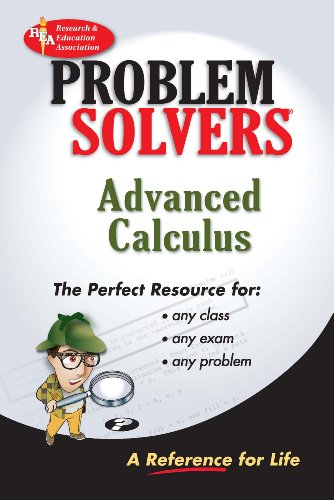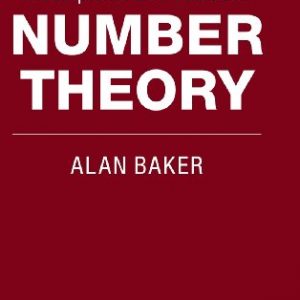Each Problem Solver is an insightful and essential study and solution guide chock-full of clear, concise problem-solving gems. All your questions can be found in one convenient source from one of the most trusted names in reference solution guides. More useful, more practical, and more informative, these study aids are the best review books and textbook companions available. Nothing remotely as comprehensive or as helpful exists in their subject anywhere. Perfect for undergraduate and graduate studies.Here in this highly useful reference is the finest overview of advanced calculus currently available, with hundreds of calculus problems that cover everything from point set theory and vector spaces to theories of differentiation and integrals. Each problem is clearly solved with step-by-step detailed solutions.DETAILS- The PROBLEM SOLVERS are unique ? the ultimate in study guides. ? They are ideal for helping students cope with the toughest subjects. ? They greatly simplify study and learning tasks. ? They enable students to come to grips with difficult problems by showing them the way, step-by-step, toward solving problems. As a result, they save hours of frustration and time spent on groping for answers and understanding. ? They cover material ranging from the elementary to the advanced in each subject. ? They work exceptionally well with any text in its field. ? PROBLEM SOLVERS are available in 41 subjects. ? Each PROBLEM SOLVER is prepared by supremely knowledgeable experts. ? Most are over 1000 pages. ? PROBLEM SOLVERS are not meant to be read cover to cover. They offer whatever may be needed at a given time. An excellent index helps to locate specific problems rapidly. ? Educators consider the PROBLEM SOLVERS the most effective and valuable study aids; students describe them as ?fantastic? ? the best books on the market.TABLE OF CONTENTSIntroductionChapter 1: Point Set TheorySets and SequencesClosed and Open Sets and NormsMetric SpacesChapter 2: Vector SpacesDefinitionsPropertiesInvertibilityDiagonalizationOrthogonalityChapter 3: ContinuityShowing that a Function is ContinuousDiscontinuous FunctionsUniform Continuity and Related TopicsParadoxes of ContinuityChapter 4: Elements of Partial DifferentiationPartial DerivativesDifferentials and the JacobianThe Chain RuleGradients and Tangent PlanesDirectional DerivativesPotential FunctionsChapter 5: Theorems of DifferentiationMean Value TheoremsTaylor?s TheoremImplicit Function TheoremChapter 6: Maxima and MinimaRelative Maximum and Relative MinimumExtremes Subject to a ConstraintExtremes in a RegionMethod of Lagrange MultipliersFunctions of Three VariablesExtreme Value in RnChapter 7: Theory of IntegrationRiemann IntegralsStieltjes IntegralsChapter 8: Line IntegralsMethod of ParametrizationMethod of Finding Potential Function (Exact Differential)Independence of PathGreen?s TheoremChapter 9: Surface Integrals Change of Variables FormulaAreaIntegral Function over a SurfaceIntegral Vector Field over a SurfaceInvergence TheoremStoke?s TheoremDifferential FormChapter 10: Improper IntegralsImproper Integrals of the 1st, 2nd, and 3rd KindAbsolute and Uniform ConvergenceEvaluation of Improper IntegralsGamma and Beta FunctionsChapter 11: Infinite SequencesConvergence of SequencesLimit Superior and Limit InferiorSequence of FunctionsChapter 12: Infinite SeriesTests for Convergence and DivergenceSeries of FunctionsOperations on SeriesDifferentiation and Integration of SeriesEstimates of Error and SumsCesaro SummabilityInfinite ProductsChapter 13: Power SeriesInterval of ConvergenceOperations on Power SeriesChapter 14: Fourier SeriesDefinitions and ExamplesConvergence QuestionsFurther RepresentationsApplicationsChapter 15: Complex VariablesComplex NumbersComplex Functions and DifferentiationSeriesIntegrationChapter 16: Laplace TransformsDefinitions and Simple ExamplesBasic Properties of Laplace TransformsStep Functions and Periodic FunctionsThe Inversion ProblemApplicationsChapter 17: Fourier TransformsDefinition of Fourier TransformsProperties of Fourier TransformsApplications of Fourier TransformsChapter 18: Differential GeometryCurvesSurfacesChapter 19: Miscellaneous Problems and ApplicationsMiscellaneous ApplicationsElliptic IntegralsPhysical ApplicationsIndexWHAT THIS BOOK IS FORStudents have generally found calculus a difficult subject to understand and learn. Despite the publication of hundreds of textbooks in this field, each one intended to provide an improvement over previous textbooks, students of advanced calculus continue to remain perplexed as a result of numerous subject areas that must be remembered and correlated when solving problems. Various interpretations of advanced calculus terms also contribute to the difficulties of mastering the subject.In a study of calculus, REA found the following basic reasons underlying the inherent difficulties of advanced calculus:No systematic rules of analysis were ever developed to follow in a step-by-step manner to solve typically encountered problems. This results from numerous different conditions and principles involved in a problem that leads to many possible different solution methods. To prescribe a set of rules for each of the possible variations would involve an enormous number of additional steps, making this task more burdensome than solving the problem directly due to the expectation of much trial and error.Current textbooks normally explain a given principle in a few pages written by a mathematician who has insight into the subject matter not shared by others. These explanations are often written in an abstract manner that causes confusion as to the principle?s use and application. Explanations then are often not sufficiently detailed or extensive enough to make the reader aware of the wide range of applications and different aspects of the principle being studied. The numerous possible variations of principles and their applications are usually not discussed, and it is left to the reader to discover this while doing exercises. Accordingly, the average student is expected to rediscover that which has long been established and practiced, but not always published or adequately explained.The examples typically following the explanation of a topic are too few in number and too simple to enable the student to obtain a thorough grasp of the involved principles. The explanations do not provide sufficient basis to solve problems that may be assigned for homework or given on examinations.Poorly solved examples such as these can be presented in abbreviated form which leaves out much explanatory material between steps, and as a result requires the reader to figure out the missing information. This leaves the reader with an impression that the problems and even the subject are hard to learn ? completely the opposite of what an example is supposed to do.Poor examples are often worded in a confusing or obscure way. They might not state the nature of the problem or they present a solution, which appears to have no direct relation to the problem. These problems usually offer an overly general discussion ? never revealing how or what is to be solved.Many examples do not include accompanying diagrams or graphs, denying the reader the exposure necessary for drawing good diagrams and graphs. Such practice only strengthens understanding by simplifying and organizing calculus processes.Students can learn the subject only by doing the exercises themselves and reviewing them in class, obtaining experience in applying the principles with their different ramifications.In doing the exercises by themselves, students find that they are required to devote considerable more time to advanced calculus than to other subjects, because they are uncertain with regard to the selection and application of the theorems and principles involved. It is also often necessary for students to discover those ?tricks? not revealed in their texts (or review books) that make it possible to solve problems easily. Students must usually resort to methods of trial and error to discover these ?tricks,? therefore finding out that they may sometimes spend several hours to solve a single problem.When reviewing the exercises in classrooms, instructors usually request students to take turns in writing solutions on the boards and explaining them to the class. Students often find it difficult to explain in a manner that holds the interest of the class, and enables the remaining students to follow the material written on the boards. The remaining students in the class are thus too occupied with copying the material off the boards to follow the professor?s explanations.This book is intended to aid students in advanced calculus overcome the difficulties described by supplying detailed illustrations of the solution methods that are usually not apparent to students. Solution methods are illustrated by problems that have been selected from those most often assigned for class work and given on examinations. The problems are arranged in order of complexity to enable students to learn and understand a particular topic by reviewing the problems in sequence. The problems are illustrated with detailed, step-by-step explanations, to save the students large amounts of time that is often needed to fill in the gaps that are usually found between steps of illustrations in textbooks or review/outline books.The staff of REA considers advanced calculus a subject that is best learned by allowing students to view the methods of analysis and solution techniques. This learning approach is similar to that practiced in various scientific laboratories, particularly in the medical fields.In using this book, students may review and study the illustrated problems at their own pace; students are not limited to the time such problems receive in the classroom.When students want to look up a particular type of problem and solution, they can readily locate it in the book by referring to the index that has been extensively prepared. It is also possible to locate a particular type of problem by glancing at just the material within the boxed portions. Each problem is numbered and surrounded by a heavy black border for speedy identification.
Advanced Calculus Problem Solver Ebook
By: Editors of REA
Publisher:
Research & Education Association
Print ISBN: 9780878915330, 0878915338
eText ISBN: 9780738668246, 0738668249
Pages: 1056
Copyright year: 2007
Format: EPUB
Available from $ 30.95 USD
SKU: 9780738668246
? Download immediately after payment and download link will send to your email.











